Validation of the Burden Distribution of the 1/3-Scale of a Blast Furnace Simulated by the Discrete Element Method
Abstract
:1. Introduction
2. Experimental
3. Simulation
3.1. Discrete Element Method
3.2. Simulation Conditions
4. Results and Discussions
5. Conclusions
- (1)
- The particle size segregation occurred during conveying to the experimental blast furnace. The smaller particles were initially discharged, whereas the larger ones were discharged later.
- (2)
- The burden profile, which was simulated using DEM, was similar to the experimental one. A terrace was found at the burden surface subsequent to ore charging, and its simulated position agreed with that of the experimental result. The surface angle was mostly similar between them.
- (3)
- The simulated O/C distribution in the radial direction and the mean particle diameter distribution showed excellent correlation with the experimental results.
- (4)
- It can be concluded that this method of particle simulation of the bell-less charging process is highly reliable in the prediction of the burden distribution in the blast furnace.
Author Contributions
Funding
Conflicts of Interest
References
- Okuno, Y.; Matsuzaki, S.; Kunitomo, K.; Isoyama, M.; Kusano, Y. Development of a mathematical model to estimate burden distribution in bell-less type charging for blast furnace. Tetsu-to-Hagané 1987, 73, 91–98. [Google Scholar] [CrossRef] [Green Version]
- Sawada, T.; Uetani, T.; Taniyoshi, S.; Miyagawa, M.; Sugawara, H.; Yamazaki, M. Blast furnace operation and burden distribution control with bell-less top of the 3 parallel bunker type. Tetsu-to-Hagané 1992, 78, 1337–1344. [Google Scholar] [CrossRef] [Green Version]
- Hattori, M.; Iino, B.; Shimomura, A.; Tsukiji, H.; Ariyama, T. Development of burden distribution simulation model for the bell-less top in a large blast furnace and its application. Tetsu-to-Hagané 1992, 78, 1345–1352. [Google Scholar] [CrossRef] [Green Version]
- Mitra, T.; Saxén, H. Model for fast evaluation of charging programs in the blast furnace. Metall. Mater. Trans. B 2014, 45, 2382–2394. [Google Scholar] [CrossRef]
- Fu, D.; Chen, Y.; Zhou, C.Q. Mathematical modeling of blast furnace burden distribution with non-uniform descending speed. Appl. Math. Model. 2015, 39, 7554–7567. [Google Scholar] [CrossRef]
- Cundall, P.A.; Strack, O.D.L. Discrete numerical model for granular assemblies. Geotechnique 1979, 29, 47–65. [Google Scholar] [CrossRef]
- Nogami, H.; Yamaoka, H.; Takatani, K. Raceway design for the innovative blast furnace. ISIJ Int. 2004, 44, 2150–2158. [Google Scholar] [CrossRef] [Green Version]
- Yuu, S.; Umekage, T.; Miyahara, T. Prediction of stable and unstable flows in blast furnace raceway using numerical simulation methods for gas and particles. ISIJ Int. 2005, 45, 1406–1415. [Google Scholar] [CrossRef] [Green Version]
- Nouchi, T.; Sato, T.; Sato, M.; Takeda, K.; Ariyama, T. Stress field and solid flow analysis of coke packed bed in blast furnace based on DEM. ISIJ Int. 2005, 45, 1426–1431. [Google Scholar] [CrossRef] [Green Version]
- Zhou, Z.; Zhu, H.; Yu, A.; Wright, B.; Pinson, D.; Zulli, P. Discrete particle simulation of solid flow in a model blast furnace. ISIJ Int. 2005, 45, 1828–1837. [Google Scholar] [CrossRef] [Green Version]
- Mio, H.; Yamamoto, K.; Shimosaka, A.; Shirakawa, Y.; Hidaka, J. Modeling of solid particle flow in blast furnace considering actual operation by large-scale Discrete Element Method. ISIJ Int. 2007, 47, 1745–1752. [Google Scholar] [CrossRef] [Green Version]
- Natsui, S.; Nogami, H.; Ueda, S.; Kano, J.; Inoue, R.; Ariyama, T. Simultaneous three-dimensional analysis of gas–solid flow in blast furnace by combining Discrete Element Method and Computational Fluid Dynamics. ISIJ Int. 2011, 51, 51–58. [Google Scholar] [CrossRef] [Green Version]
- Wu, S.; Kou, M.; Xu, J.; Guo, X.; Du, K.; Shen, W.; Sun, J. DEM simulation of particle size segregation behavior during charging into and discharging from a Paul-Wurth type hopper. Chem. Eng. Sci. 2013, 99, 314–323. [Google Scholar] [CrossRef]
- Yu, Y.; Saxén, H. Segregation behavior of particles in a top hopper of a blast furnace. Powder Technol. 2014, 262, 233–241. [Google Scholar] [CrossRef]
- Liu, S.; Zhou, Z.; Dong, K.; Yu, A.; Pinson, D.; Tsalapatis, J. Numerical investigation of burden distribution in a blast furnace. Steel Res. Int. 2015, 86, 651–661. [Google Scholar] [CrossRef]
- Mio, H.; Komatsuki, S.; Akashi, M.; Shimosaka, A.; Shirakawa, Y.; Hidaka, J.; Kadowaki, M.; Matsuzaki, S.; Kunitomo, K. Validation of particle size segregation of sintered ore during flowing through laboratory-scale chute by Discrete Element Method. ISIJ Int. 2008, 48, 1696–1703. [Google Scholar] [CrossRef] [Green Version]
- Mio, H.; Komatsuki, S.; Akashi, M.; Shimosaka, A.; Shirakawa, Y.; Hidaka, J.; Kadowaki, M.; Matsuzaki, S.; Kunitomo, K. Effect of chute angle on charging behavior of sintered ore particles at bell-less type charging system of blast furnace by Discrete Element Method. ISIJ Int. 2009, 49, 479–486. [Google Scholar] [CrossRef] [Green Version]
- Mio, H.; Kadowaki, M.; Matsuzaki, S.; Kunitomo, K. Development of particle flow simulator in charging process of blast furnace by discrete element method. Miner. Eng. 2012, 33, 27–33. [Google Scholar] [CrossRef]
- Mio, H.; Nakauchi, T.; Kawaguchi, Y.; Enaka, T.; Narita, Y.; Inayoshi, A.; Matsuzaki, S.; Orimoto, T.; Nomura, S. High-speed video recording of particle trajectory via rotating chute of Nagoya No.3 blast furnace and its comparison with simulated behavior using DEM. ISIJ Int. 2017, 57, 272–278. [Google Scholar] [CrossRef] [Green Version]
- Mio, H.; Narita, Y.; Matsuzaki, S.; Nishioka, K.; Nomura, S. Measurement of particle charging trajectory via rotating chute of 1/3-scale blast furnace and its comparing with numerical analysis using Discrete Element Method. Powder Technol. 2019, 344, 797–803. [Google Scholar] [CrossRef]
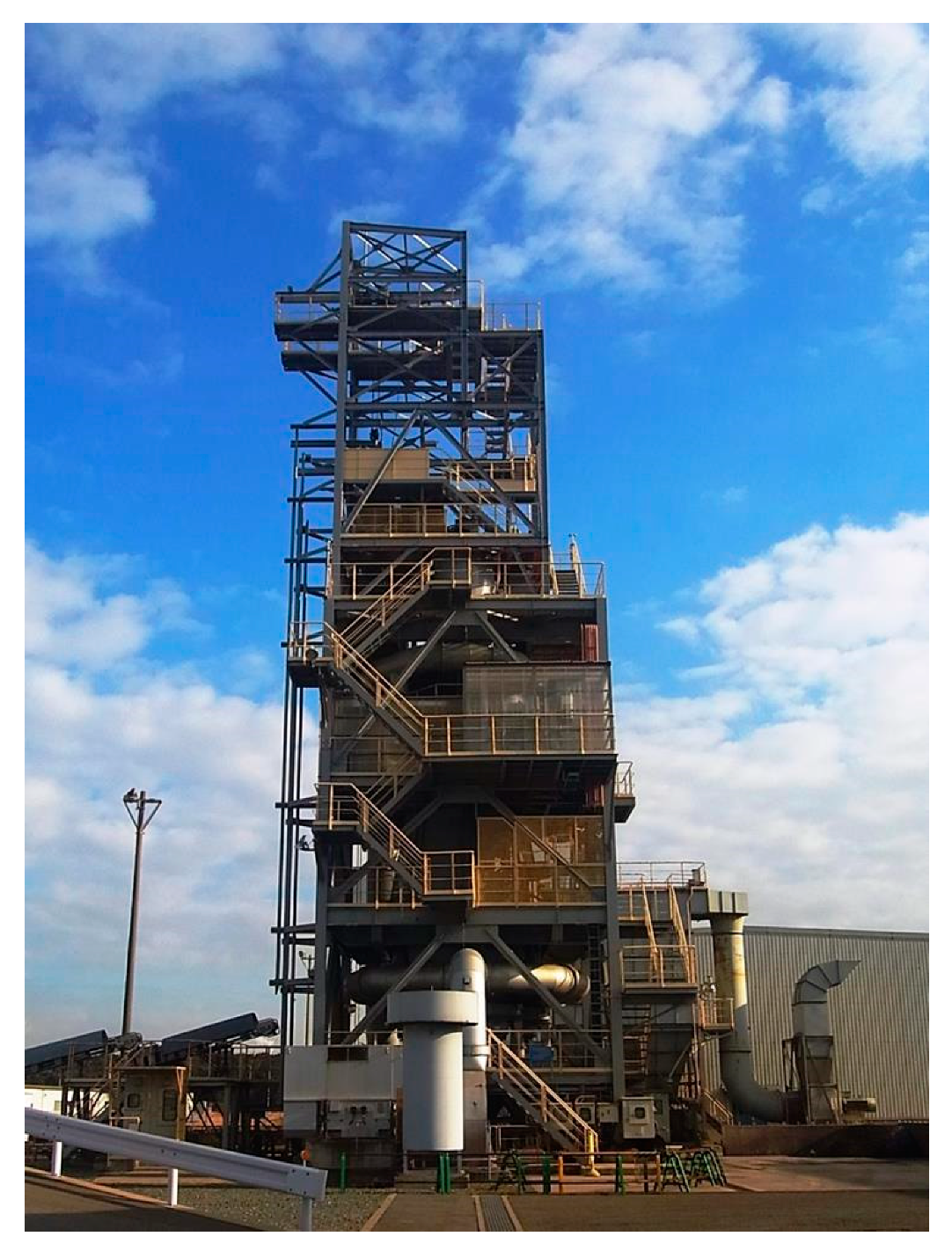

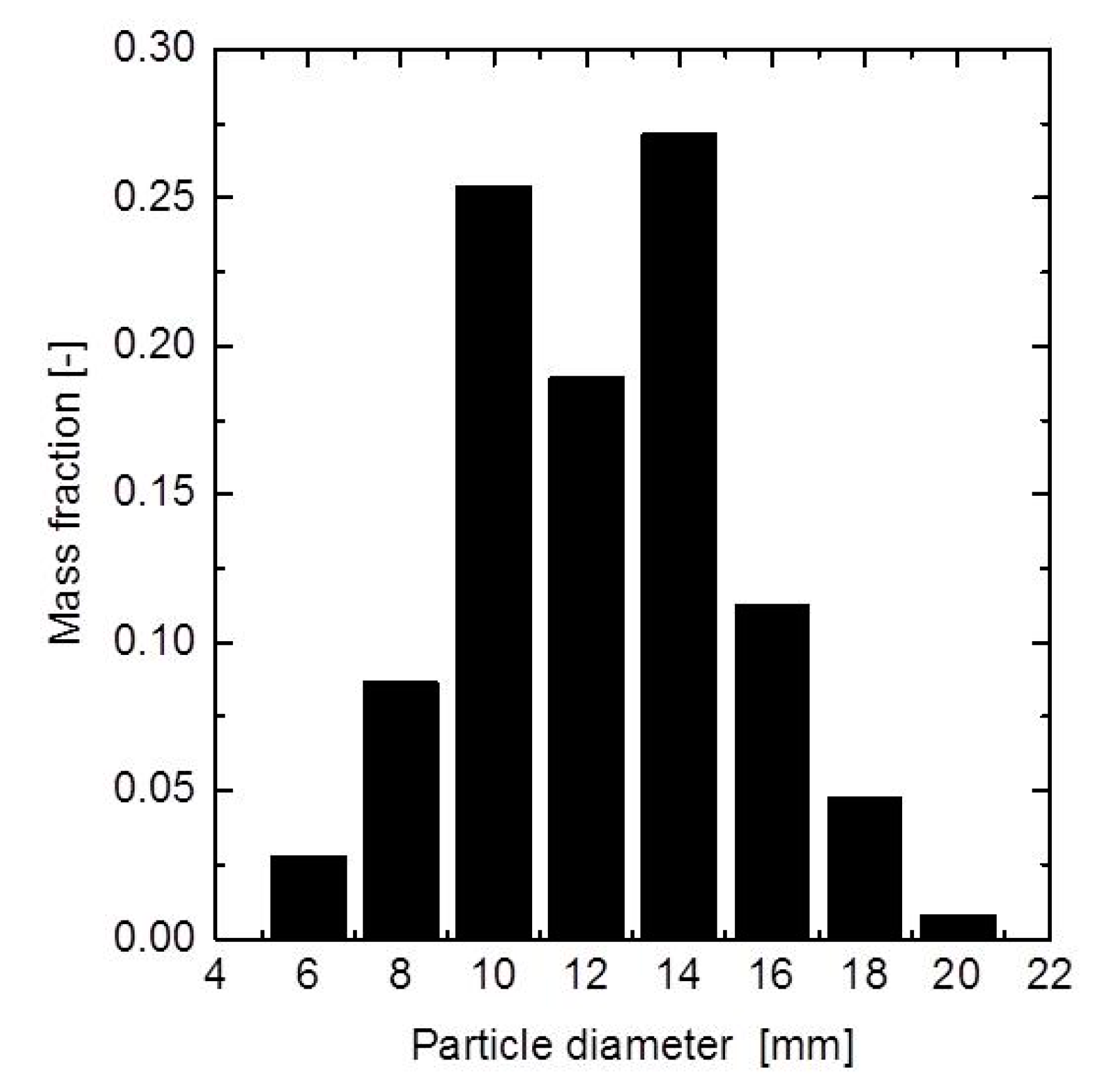
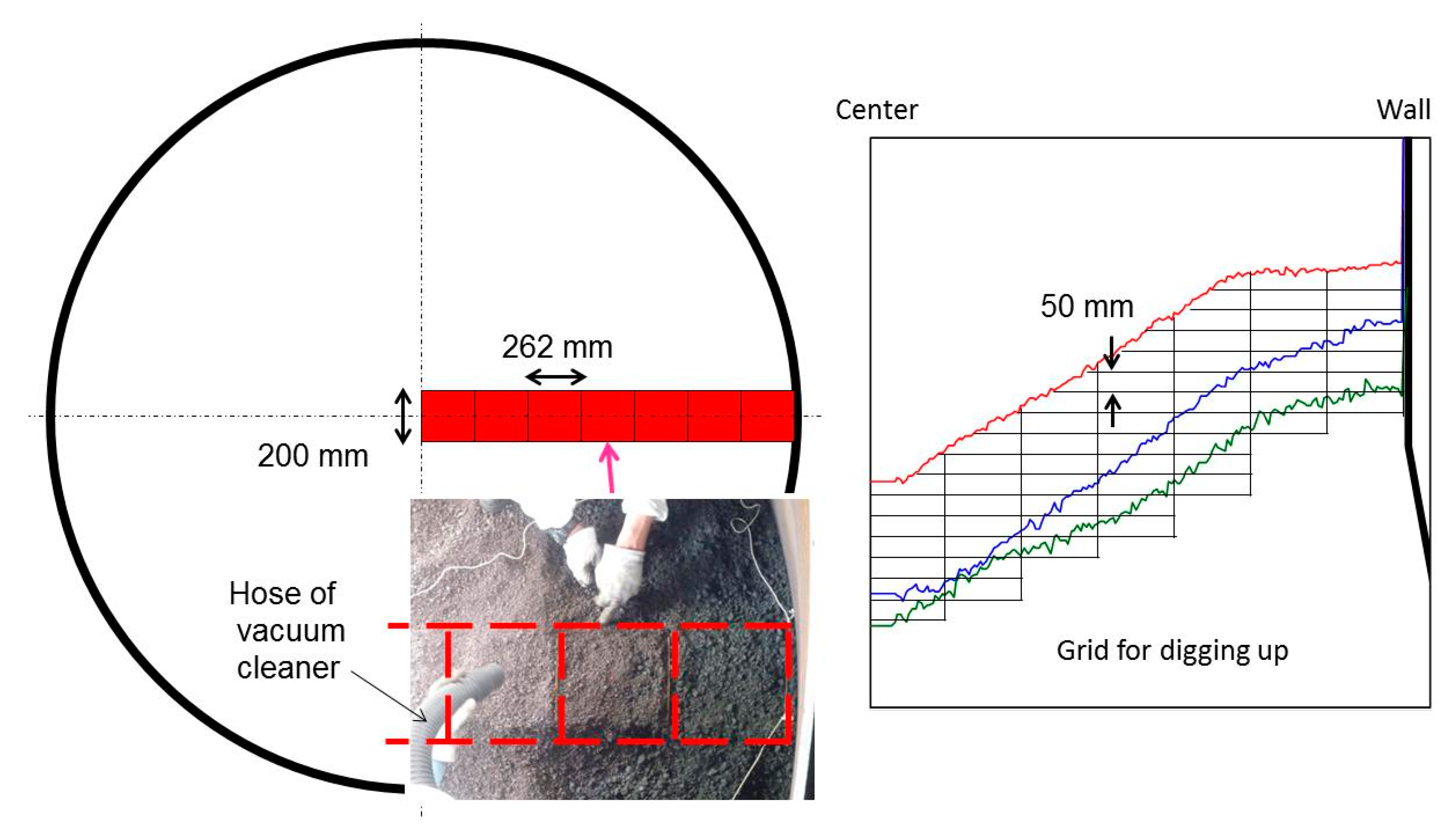
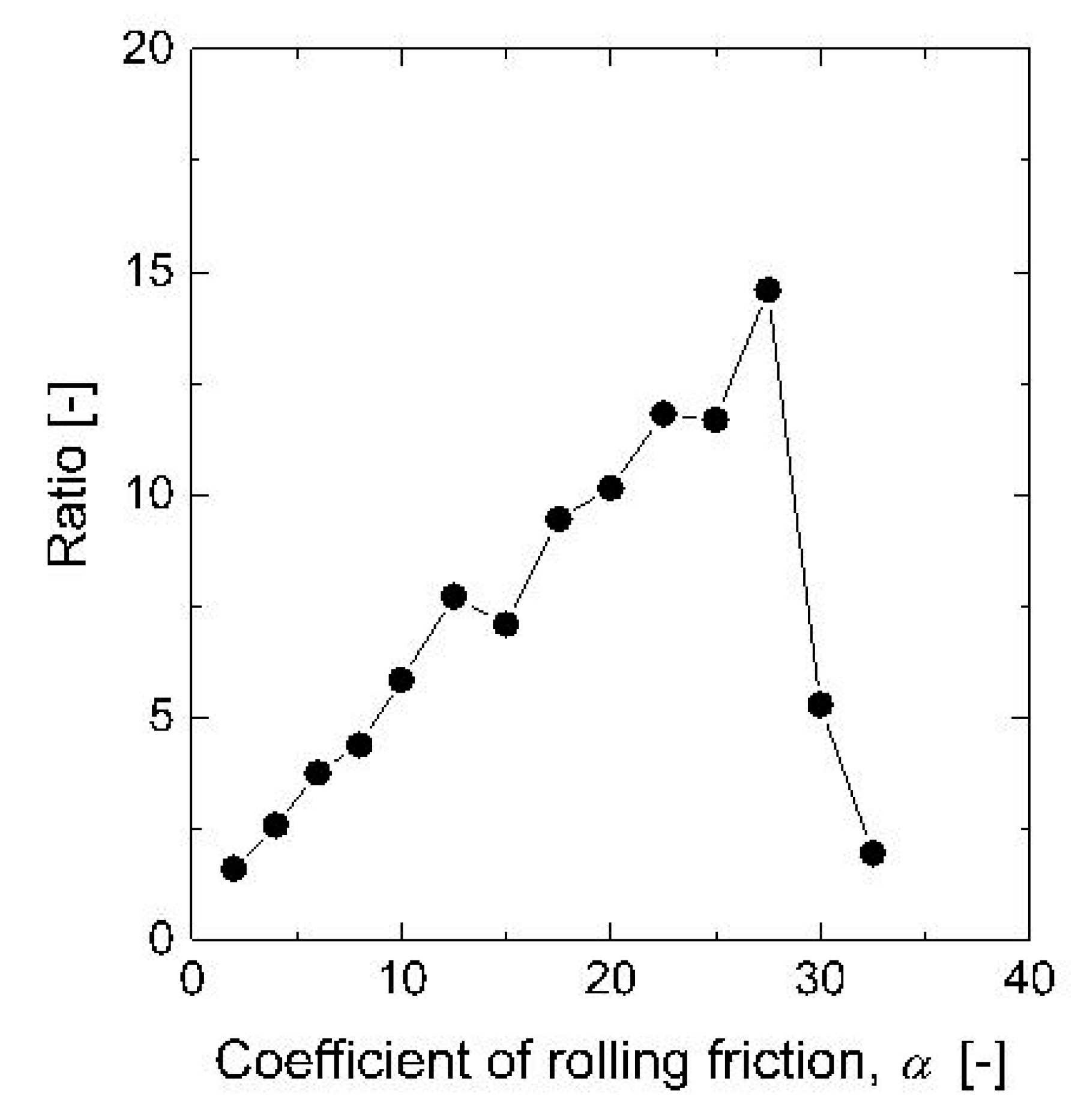
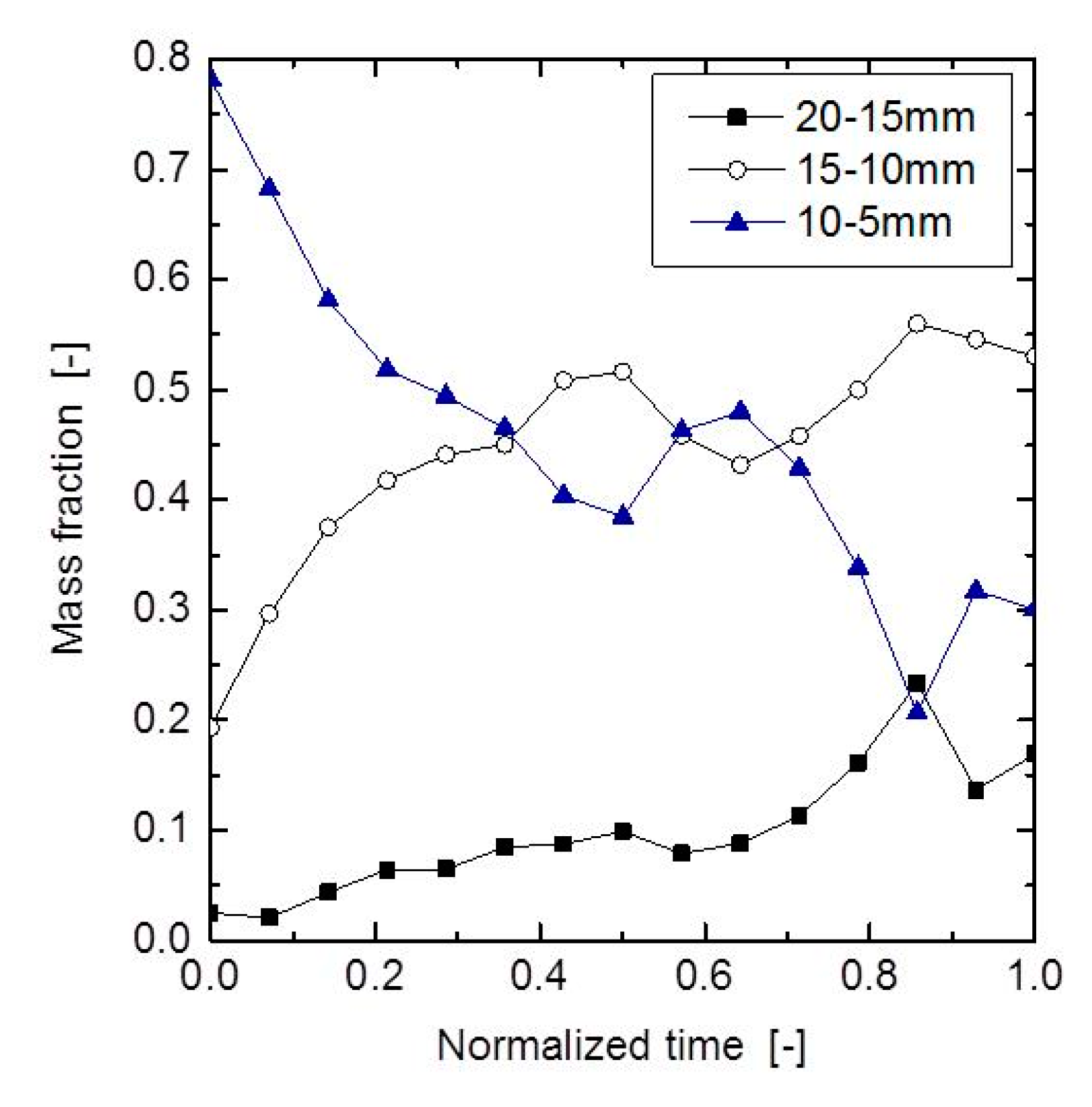
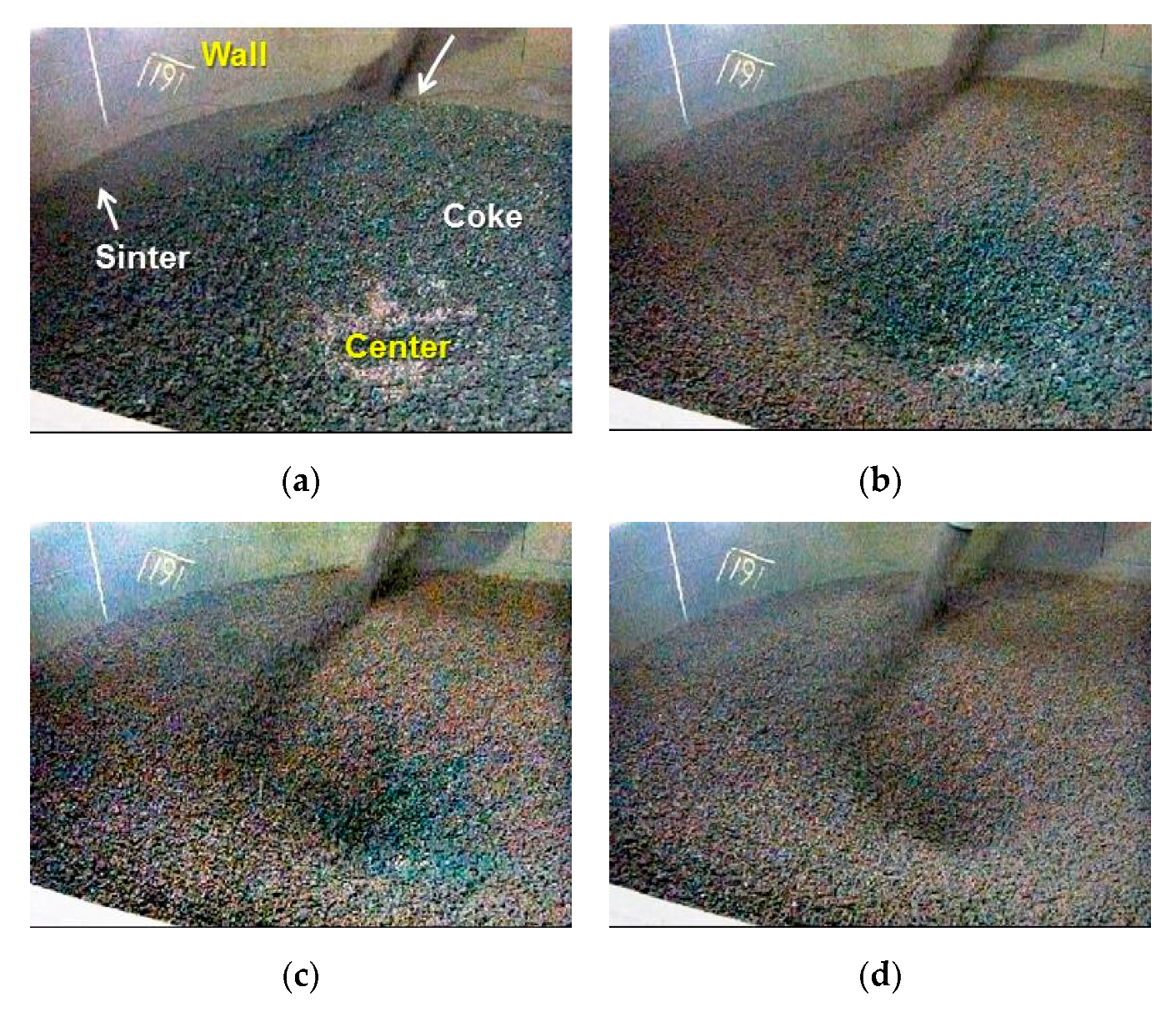
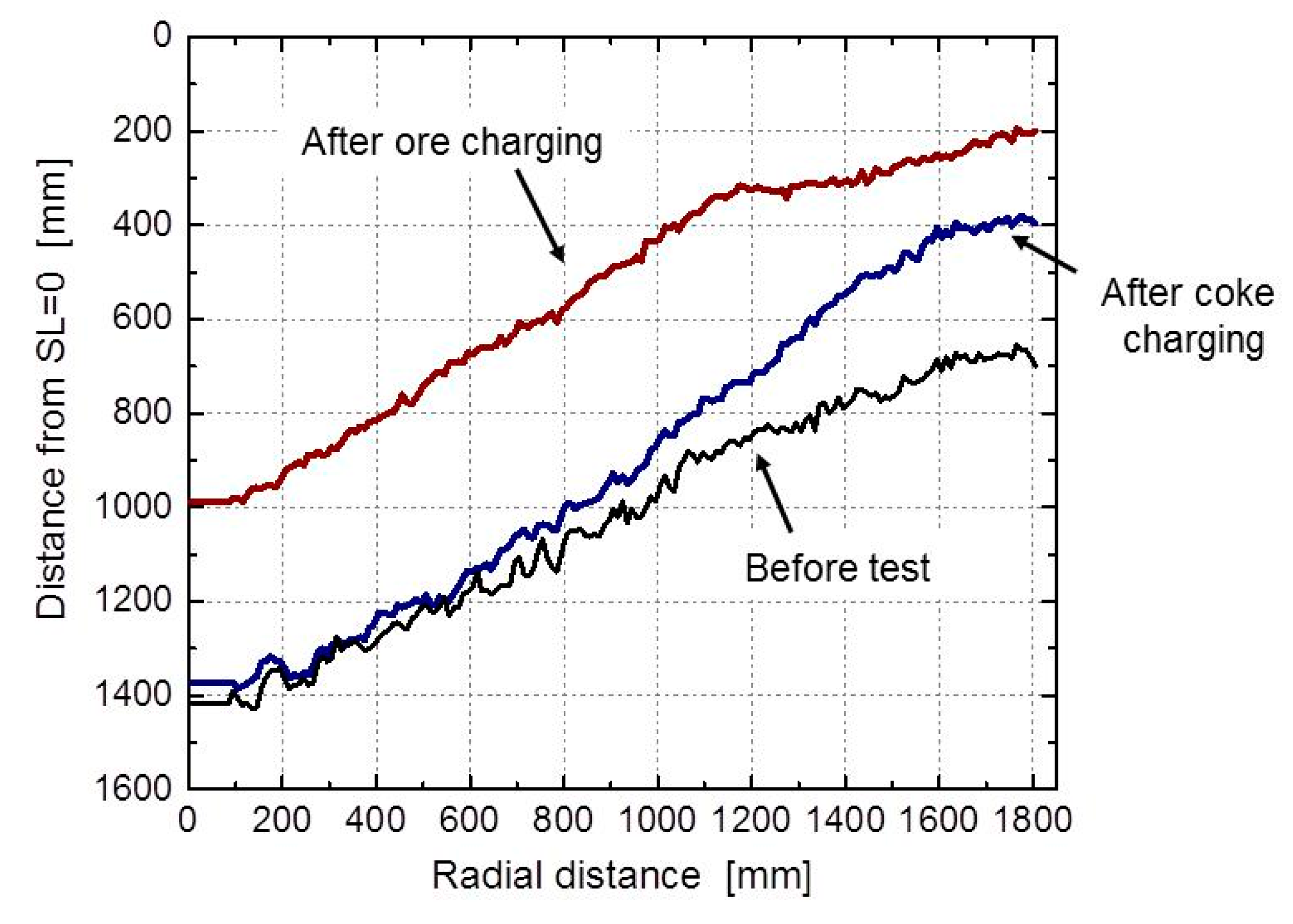
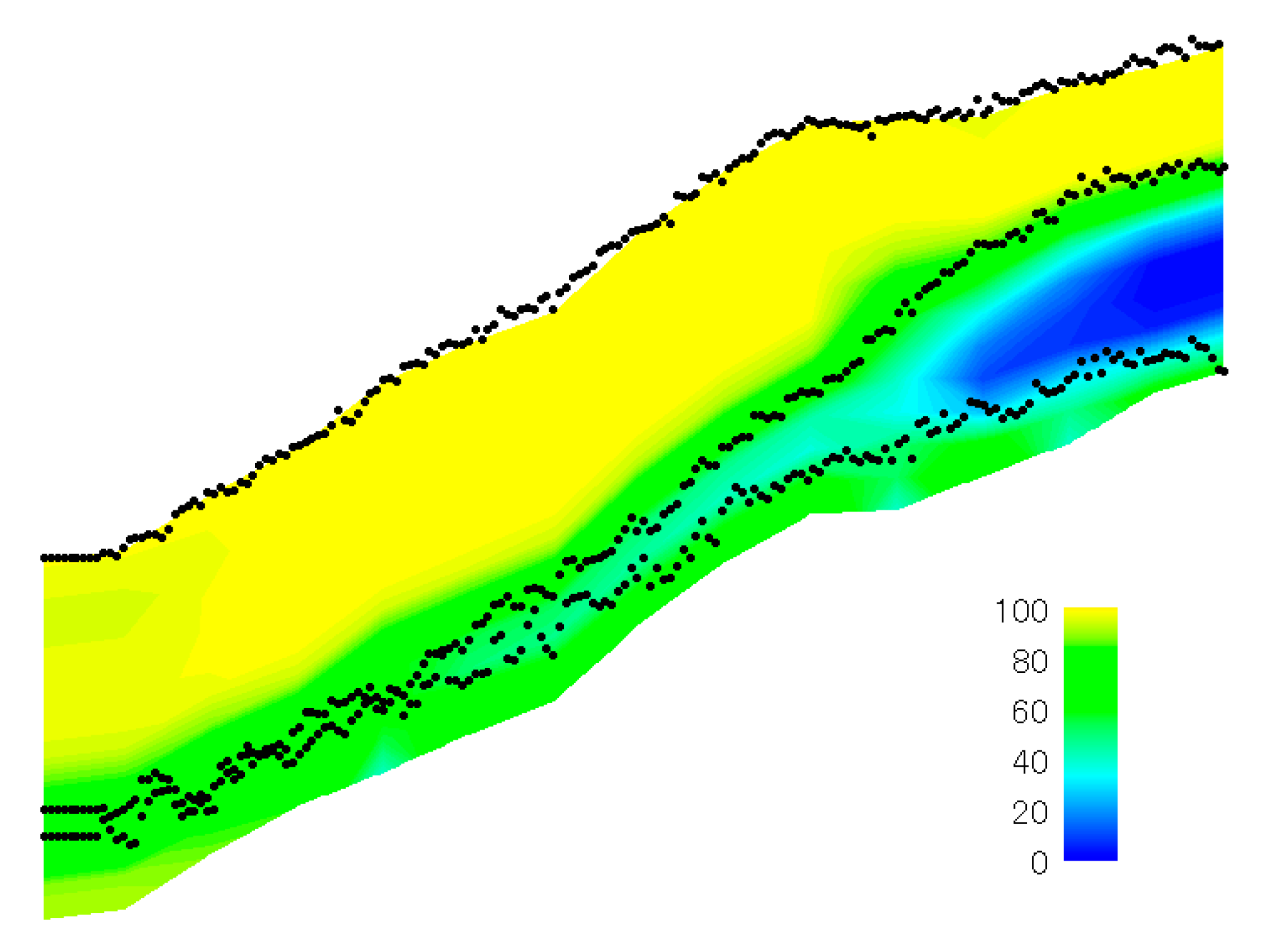
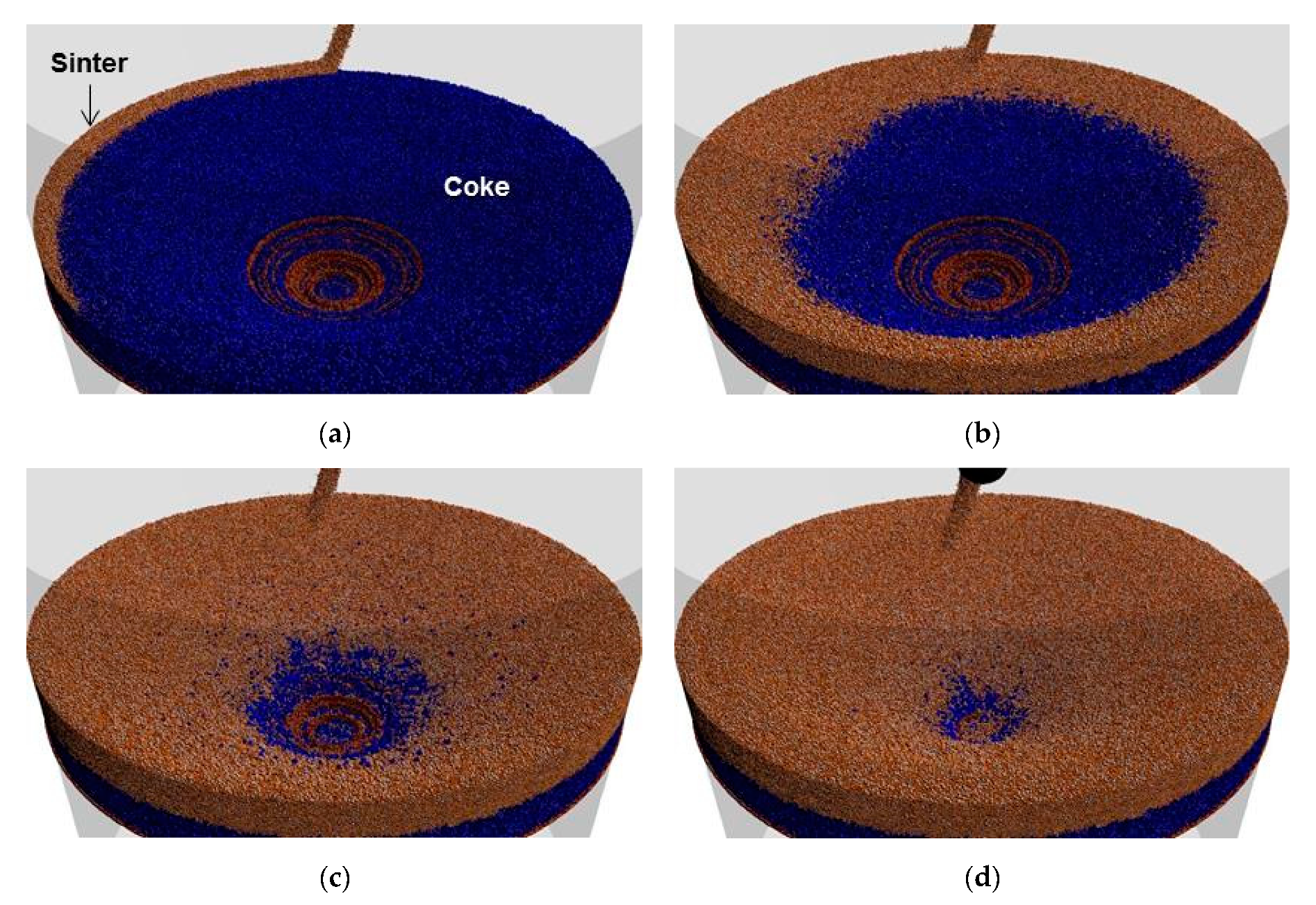



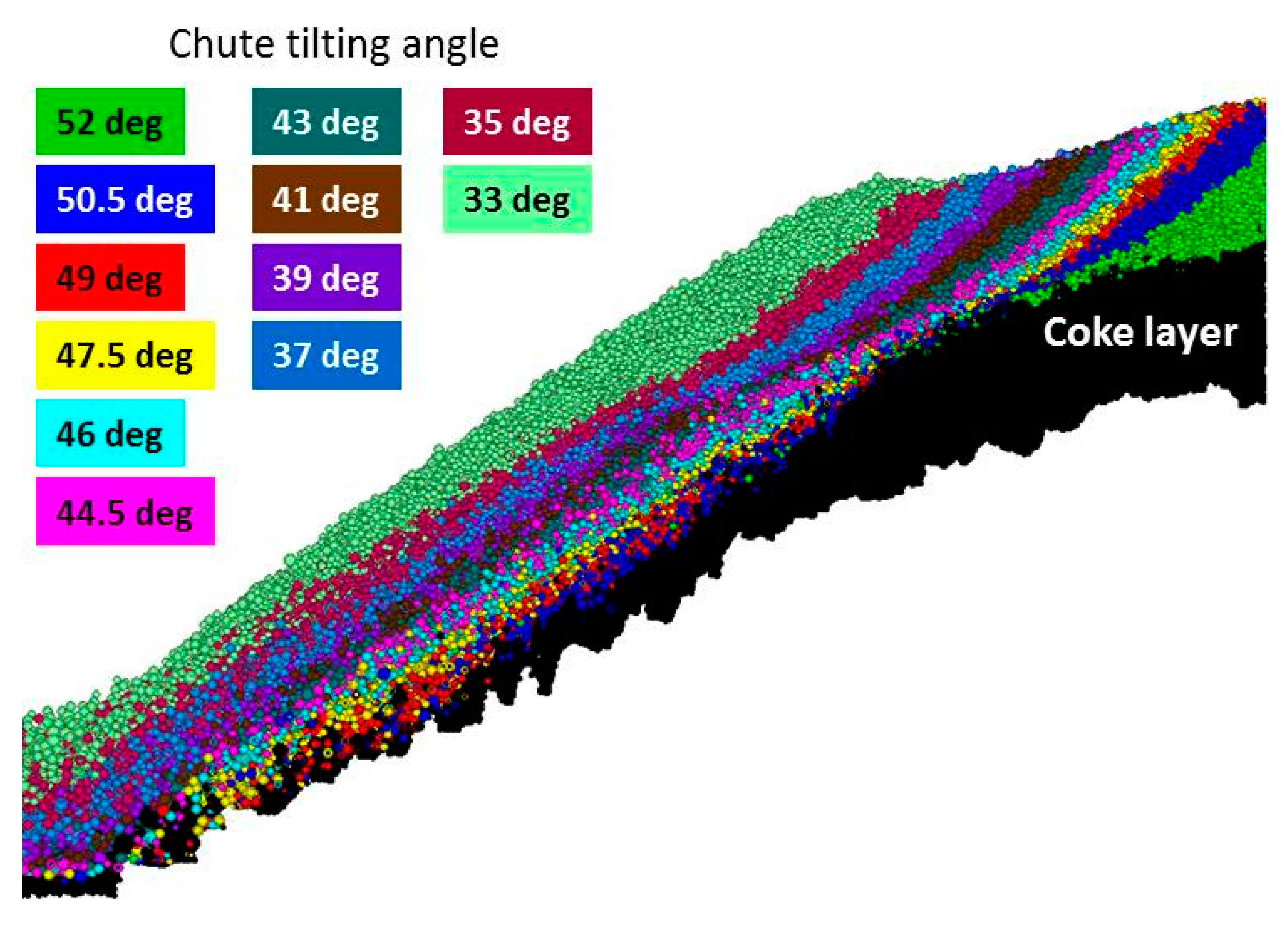
| Chute Angle [°] | 52 | 50.5 | 49 | 47.5 | 46 | 44.5 | 43 | 41 | 39 | 37 | 35 | 33 | Mass [kg] |
|---|---|---|---|---|---|---|---|---|---|---|---|---|---|
| Coke | 2 | 2 | 1 | 1 | 1 | 1 | 1 | 1 | 1250 | ||||
| Ore | 2 | 2 | 1 | 1 | 1 | 1 | 1 | 1 | 1 | 1 | 1 | 2 | 5500 |
| Particle Diameter [mm] | Number of Particle [-] | Mass Fraction [-] |
|---|---|---|
| 6 | 414,382 | 0.028 |
| 8 | 539,490 | 0.087 |
| 10 | 809,088 | 0.254 |
| 12 | 349,403 | 0.190 |
| 14 | 315,434 | 0.272 |
| 16 | 87,722 | 0.113 |
| 18 | 26,239 | 0.048 |
| 20 | 3328 | 0.008 |
| Particle Diameter [mm] | Number of Particle [-] | Mass Fraction [-] |
|---|---|---|
| 7.5 | 695,453 | 0.151 |
| 12.5 | 216,471 | 0.218 |
| 17.5 | 90,753 | 0.251 |
| 22.5 | 34,048 | 0.200 |
| 30 | 12,961 | 0.180 |
© 2019 by the authors. Licensee MDPI, Basel, Switzerland. This article is an open access article distributed under the terms and conditions of the Creative Commons Attribution (CC BY) license (http://creativecommons.org/licenses/by/4.0/).
Share and Cite
Mio, H.; Narita, Y.; Nakano, K.; Nomura, S. Validation of the Burden Distribution of the 1/3-Scale of a Blast Furnace Simulated by the Discrete Element Method. Processes 2020, 8, 6. https://doi.org/10.3390/pr8010006
Mio H, Narita Y, Nakano K, Nomura S. Validation of the Burden Distribution of the 1/3-Scale of a Blast Furnace Simulated by the Discrete Element Method. Processes. 2020; 8(1):6. https://doi.org/10.3390/pr8010006
Chicago/Turabian StyleMio, Hiroshi, Yoichi Narita, Kaoru Nakano, and Seiji Nomura. 2020. "Validation of the Burden Distribution of the 1/3-Scale of a Blast Furnace Simulated by the Discrete Element Method" Processes 8, no. 1: 6. https://doi.org/10.3390/pr8010006






